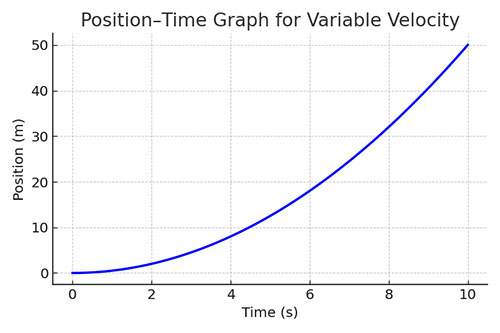Physics and Mathematics
Velocity
1. Introduction
Velocity is defined as the rate of change of displacement of a body with respect to time.
It is a vector quantity — meaning it has both magnitude (speed) and direction.
[v = \dfrac{\Delta s}{\Delta t}]
Where:
- [v] = velocity
- [\Delta s] = displacement
- [\Delta t] = time interval
2. SI Unit and Dimensional Formula
- SI Unit: [m/s]
- Dimensional Formula: [M^0 L^1 T^{-1}]
3. Important Notes
- If direction changes while the speed remains constant, velocity still changes.
- If displacement is zero, velocity is zero, regardless of the distance covered.
- Velocity may be positive, negative, or zero depending on the direction of motion.
4. Types of Velocity
4.1 Uniform Velocity
A body is said to have uniform velocity if it covers equal displacements in equal intervals of time along a straight line and in the same direction.
[v = \dfrac{\Delta s}{\Delta t} \quad \text{(displacement is constant in each interval)}]
4.2 Variable Velocity
A body is said to have variable velocity if either its magnitude or direction (or both) change with time.
Examples:
- A car speeding up or slowing down on a straight road.
- A stone moving in a circular path at constant speed (direction changes → velocity changes).
4.3 Average Velocity
Defined as the total displacement divided by the total time taken.
[v_{avg} = \dfrac{\text{Total Displacement}}{\text{Total Time Taken}}]
⚡ Important: Average velocity depends on displacement, unlike average speed which depends on distance.
4.4 Instantaneous Velocity
The velocity of a body at a particular instant of time or at a specific point of its path.
Mathematically:
[v_{inst} = \dfrac{ds}{dt}]
Where [s] is displacement and [t] is time.
5. Graphical Interpretation
- Position–Time Graph:
- Slope of the position–time graph at a point gives the instantaneous velocity at that instant.


- Velocity–Time Graph:
- For uniform velocity, the graph is a straight horizontal line.

Image Credit: Ucale.org - For variable velocity, the graph is slanted or curved, depending on the nature of change.
- For uniform velocity, the graph is a straight horizontal line.

6. Important Formulas to Remember
| No. | Formula | Description |
|---|---|---|
| 1 | [v = \dfrac{\Delta s}{\Delta t}] | Velocity is displacement per unit time. |
| 2 | [v_{avg} = \dfrac{\text{Total Displacement}}{\text{Total Time}}] | Average velocity over a time interval. |
| 3 | [v_{inst} = \dfrac{ds}{dt}] | Instantaneous velocity at a particular moment of time. |
| 4 | [v = u + at] | Velocity in uniformly accelerated motion, where [u] = initial velocity, [a] = acceleration, [t] = time. |
7. Conceptual Questions
1. How is velocity different from speed?
Speed is scalar and depends on distance, while velocity is vector and depends on displacement.
2. Can velocity be zero when speed is not zero?
Yes. For example, in uniform circular motion after completing a full circle, displacement is zero, hence velocity is zero, though speed is constant.
3. A car moves 5 km east and then 5 km west in 1 hour. What is its average velocity?
Total displacement = 0 ⇒ [v_{avg} = \dfrac{0}{1} = 0 \, \text{km/h}]
4. If the velocity of an object changes only in direction, is the motion still accelerated?
Yes. Any change in either magnitude or direction of velocity results in acceleration.
5. What does the slope of a position–time graph represent?
The slope represents the velocity of the object at that point.
6. Is it possible for average velocity to be negative?
Yes, if the overall displacement is in the negative direction of the chosen reference axis.
7. Why is instantaneous velocity defined using differentiation?
Because it measures the rate of change of displacement at an infinitesimally small interval of time.
8. Can a body moving at constant speed have variable velocity?
Yes, if it changes its direction of motion, as in circular motion.
9. A car moves with uniform velocity for 10 s and then rests for 5 s. What is its instantaneous velocity during rest?
During rest, instantaneous velocity = 0.
10. How is average velocity calculated when an object changes direction?
Average velocity is calculated using the total displacement vector divided by the total time.
8. FAQs / Common Misconceptions
1. If velocity is zero, does it mean the object did not move?
Not necessarily. It means the **net displacement is zero**, even though the object may have moved back and forth.
2. Can an object have constant velocity but non-zero acceleration?
No. Constant velocity implies zero acceleration.
3. If speed is constant, is velocity always constant?
Not necessarily. If the direction changes (like in circular motion), velocity changes even if speed remains constant.
4. Does zero average velocity mean the object was always at rest?
No. It means that the final position is the same as the initial position (zero net displacement), not that it never moved.